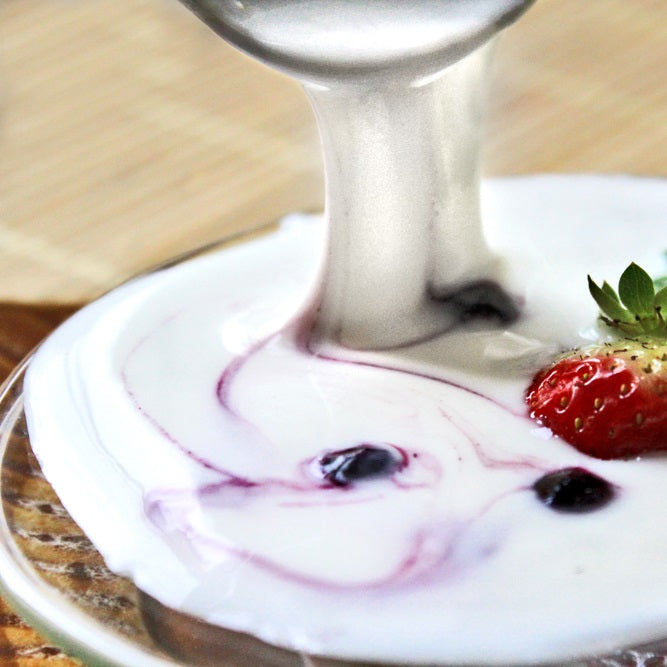
In our household, Viili yogurt is a fun treat. We usually drink milk kefir every day, but once in a while we take a break and eat some Viili instead. It's refreshingly mild compared to kefir and the thick ropy texture makes it a delight for us. The good news about Viili is that its not just for fun. It has plenty of its own health benefits.
How is Viili made?
Viili is a room temperature yogurt that typically ferments milk within 8-12 hours at room temperature. Some people who do homemade yogurt are shocked at how easy viili is.
There's no heating involved nor any kind of incubation chamber.
Throw away the thermometer and simply combine the viili starter with cold milk in a jar, cover and let sit for 8-12 hours. Chill in fridge overnight and you have delicious ropy viili the next morning. It's that simple.
What exactly is Viili?
The strong ropy characteristic of Viili (the snotty, stringy, slimy texture) is what they call exopolysaccharides (EPS). The EPS is produced by lactoccoccal bacteria strains. The main strain is Lactococcus lactis ssp. cremoris.
Interestingly enough, the EPS (slime in viili) is what confers many of the health benefits.
Other strains commonly found in viili are Lactococcus lactis subsp. lactis biovar. diacetylactis, Leuconostoc mesenteroides subsp. cremoris. Lactobacillus plantarum, Streptococcus thermophilus, Lactobacillus paracasei, Bacillus cereus and Lactobacillus delbrueckii[1].
The common yeast strains are Kluveromyces marxianus and Pichia fermentans
Probiotic count (CFU) of Viili
Three viili starters were tested and found that the lactococcal bacteria ranged from 7.82 to 8.32 log cfu/mL[2]. Which means it averages about 100 million cfu per ml or gram. Basically comes out to be 2.5 billion CFU per cup of Viili. Not as impressive as milk kefir probiotics, but still quite respectable for being so mild.
Viili may lower cholesterol
In an interesting study involving rats[3], they split the rats into 3 groups. One group of rats received the viili strain that produces the ropy kind of viili. Another group received the equaivlant villi but without the ropy quality. The last group received just acidified milk.
Out of all the groups, the rats that ingested the viili with the ropy / slimy quality had to lowest cholesterol. Not only that, the HDL (the good cholesterol) was higher in the rats that had the ropy viili. Even though it was done with rats, it sounds promising.
Inhibits Cancer
One study involving the main strain of viili (Lactococcus lactis ssp. cremoris) demonstrated anti-tumor capabilities[4]. They isolated the Viili strain and tested it against tumor growth in a lab. After 9 days of administration, the tumor growth was significantly suppressed.
Stimulates and modulates immune function
One study showed an increase of mitogenic activity with B-cells[5]. B-cells are part of the immune typically associated with anti-bodies. A second study shows that stimulation of the T-cells (responsible for destroying germs and cancer) with the viili strain[6]. It's likely that these immune responses are part of the reason why they also suppress tumor growth.
Nutritional
The viili helps make the milk more nutritious, somewhat similar to milk kefir's nutritional profile. There is less lactose sugar in the end. There's more biotin, folate, bio-active peptides, beneficial acids, important B and K vitamins, etc. Also the vitamins are more bio-available to the body.
Less Yeast than Milk kefir
Compared to milk kefir, viili (and all room temperature yogurts) have less overall yeast. It's the reason it sets harder and is less likely to separate into curds and whey. There's more bacteria compared to the yeast.
They have less overall yeast than the scoby ferments (milk kefir, water kefir, ginger beer, kombucha), but they will have more yeast than traditional yogurts. They are basically in the middle with yeast content. That's one of the reasons why you have to heat traditional yogurt as the bacteria needs assistance since they don't have yeast to help. The room temperature yogurts have a little yeast to help kick start the process and ferment in a natural environment.
Bottom Line
Viili is thick, delicious, fun and very easy to make. But its healthy too. It has the potential to lower cholesterol and increase the good cholesterol (HDL). It can help fight against cancer or foreign germs. It's also good nutrition.
If you are looking for the healthiest culture possible, we tend to recommend milk kefir. Ideally raw goats milk kefir. It's well studied and has many health benefits, such as lowering blood pressure, high CFU count, anti-cancer, immune supportive, great for muscle recovery and bowel movement.
However, viili should not be dismissed either. It does not have a lot of research behind it, but the studies do show interesting health benefits. Interestingly enough, much of the benefits actually arise from the ropy nature (the EPS) of viili. Milk kefir has keferin which is somewhat similar, but does not have the same ropy slime forming ability (unless crossed with viili). It also has less yeast than milk kefir. So eating both or alternating between them may be a good option for those trying to get the most benefits.
Have you noticed any health benefits from eating viili?
Sources:
1. https://pdfs.semanticscholar.org/933d/2862306a518ce4fbbc5508bc54689b6c86c1.pdf
2. https://www.sciencedirect.com/science/article/pii/S0022030206723074#bib8
3. https://onlinelibrary.wiley.com/doi/abs/10.1111/j.1365-2621.1992.tb06848.x
4. http://agris.fao.org/agris-search/search.do?recordID=JP9104007
5. https://www.sciencedirect.com/science/article/pii/S0022030292780576
6. https://www.sciencedirect.com/science/article/pii/0168160587900717


Comments
Nancy
December 01, 2019
Jane Mickelborough
I found this page after searching for “rubbery kefir” My current batch of kefir grains is producing something that looks, acts and tastes very much like the viili described here. I’m delighted to discover this new treat that appears to have developed by accident. I now have two kefir cultures that are both very different. My experience with lactofermented foods is that the severe arthritis in my fingers is greatly eased if I stick to an organic diet with predominantly fermented ingredients (kefir, yogourt, sourdough, kimchi, sauerkraut). This diet has dramatically slowed the development of stiffness and pain in my fingers, and it is very noticeable, if I am unable to source suitable food , how the pain increases rapidly again.
November 30, 2019
than you for such informative honest no nonensence posts
thank you for such I formative honest no nonensence posts
April 25, 2019
Leave a comment